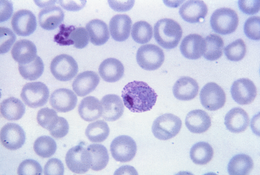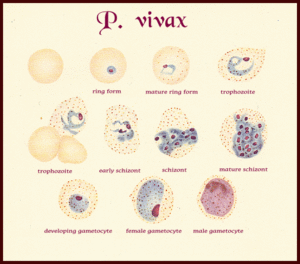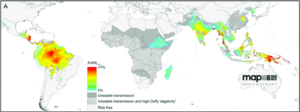Plasmodium vivax: Difference between revisions
| Line 88: | Line 88: | ||
[c] [https://www.ncbi.nlm.nih.gov/pmc/articles/PMC5198891/ Am J Trop Med Hyg. 2016 Dec 28; 95(6 Suppl): 15–34. doi: 10.4269/ajtmh.16-0141] | [c] [https://www.ncbi.nlm.nih.gov/pmc/articles/PMC5198891/ Am J Trop Med Hyg. 2016 Dec 28; 95(6 Suppl): 15–34. doi: 10.4269/ajtmh.16-0141] | ||
[d] | [d] [https://www.cell.com/trends/parasitology/fulltext/S1471-4922(03)00066-7?_returnURL=https%3A%2F%2Flinkinghub.elsevier.com%2Fretrieve%2Fpii%2FS1471492203000667%3Fshowall%3Dtrue J. Carlton The Plasmodium vivax genome sequencing project Trends Parasitol., 19 (2003), pp. 227-231] | ||
==Author== | ==Author== | ||
Revision as of 23:55, 29 April 2020
Classification
Domain: Eukaryote
Phylum: Apicomplexa
Class: Aconoidasida
Order: Haemosporida
family: Plasmodiidae
Species
|
NCBI: Taxonomy |
Plasmodium vivax
Description and Significance
Appearance
P. vivax are parasites found inhabiting the liver and blood at various stages of development and shape. Starting as rings within red blood cells, then trophozoites as they develop within the red blood cells. Next, they form round gametocytes filling the red blood cells and schizonts which are elongated and wormlike, further filling out the red blood cells. Red blood cells infected by P. vivax cause swelling of the cell, increasing the size by approximately 1.5 times the size.
Habitat
P. vivax is found within South America and Asia, along with smaller amounts found within the horn of africa and Madagascar. P. vivax is the most widespread of human malaria, with farther reaches than the temperate limited Plasmodium falciparum more commonly known, enabled by the parasite forming a dormant stage within the human liver, enabling safe storage for the parasite during mosquito-free cold seasons.[b]
Signifigacne
P. vivax has great signifigance due to the formation of hypnozoites within livers of infected human hosts. This hypnozoite stage leads to a "hybernation" where P. vivax remains dormant until unknown (but linked to mosquito vector bites[b]) factors trigger growth, and relapses of symptoms weeks, months, or years later, remaining infectious throughout [c]. This continual infectious period makes treatment, eradication, and control of the parasite difficult.[c]
Genome Structure
Describe the size and content of the genome. How many chromosomes? Circular or linear? Other interesting features? What is known about its sequence?
P. vivax has a genome charaterized by 12-14 linear chromosomes with a range of 1.2 Mb to 3.5 Mb, with an estimated genome of 35 - 40 Mb. Protein-coding genes have been attributed to GC-rich isochores and chromosome ends with AT-rich isochores at the telomeres.[d]
Cell Structure, Metabolism and Life Cycle
Metablism
Life Cycle / Cell Structure
Plasmodium genus eukaryotes form a typical lifecycle characterized by infection from insect host to vertebrate host. P. vivax first enters a vertebrate host through injection by Anopheles mosquitoes (female only) where P. vivax makes their way from the blood to the liver, entering hepatic cells and undergoing replication before exiting to infect erythrocytes and forming hypnozoites and merozoites, some differing to form gametocytes to be picked up by other mosquitoes to continue the cycle.
Human Infection
Liver Stage
Erythrocytic Stage
Mosquito Infection
Fertilization
Sporogony
Ecology and Pathogenesis
Habitat; symbiosis; biogeochemical significance; contributions to environment.
If relevant, how does this organism cause disease? Human, animal, plant hosts? Virulence factors, as well as patient symptoms.
Symbiosis
Symptoms
References
[a] Vogel G. The forgotten malaria. Science. 2013;342(6159):684‐687. doi:10.1126/science.342.6159.684
[c] Am J Trop Med Hyg. 2016 Dec 28; 95(6 Suppl): 15–34. doi: 10.4269/ajtmh.16-0141
[d] J. Carlton The Plasmodium vivax genome sequencing project Trends Parasitol., 19 (2003), pp. 227-231
Author
Page authored by Jonathan Ward, student of Prof. Jay Lennon at IndianaUniversity.



